
Galicia is an autonomous community of Spain and historic nationality under Spanish law. Located in the northwest Iberian Peninsula, it includes the provinces of A Coruña, Lugo, Ourense, and Pontevedra.

A ghost town, deserted city, extinct town, or abandoned city is an abandoned settlement, usually one that contains substantial visible remaining buildings and infrastructure such as roads. A town often becomes a ghost town because the economic activity that supported it has failed or ended for any reason. The town may have also declined because of natural or human-caused disasters such as floods, prolonged droughts, extreme heat or extreme cold, government actions, uncontrolled lawlessness, war, pollution, or nuclear and radiation-related accidents and incidents. The term can sometimes refer to cities, towns, and neighborhoods that, though still populated, are significantly less so than in past years; for example, those affected by high levels of unemployment and dereliction.

Ourense is a province of Spain, in the southeastern part of the autonomous community of Galicia. It is bordered by the provinces of Pontevedra to the west, Lugo to the north, León and Zamora, to the east, and by Portugal to the south. With an area of 7,278 square km., it is the only landlocked province in Galicia. The provincial capital, Ourense, is the largest population centre, with the rest of the province being predominantly rural.
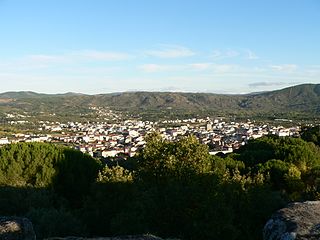
Verín is a town and municipality in the southeast of the province of Ourense, in the autonomous community of Galicia, Spain. The population of the municipality is about 14,433. It is located 70 kilometers east of the provincial capital of Ourense and 15 kilometers north of the Portuguese city of Chaves. The Tâmega River flows through the town. In the Middle Ages it was known as Santa María de Verín.

Ourense is a city and the capital of the province of Ourense, located in the autonomous community of Galicia, northwestern Spain. It is on the Camino Sanabrés path of the Way of St James, and is crossed by the Miño, Barbaña, Loña and Barbañica rivers. It is also known as A cidade das Burgas due to its hot springs, being one of the European cities with the greatest thermal heritage.

Xinzo de Limia is a town and municipality in the province of Ourense, in the autonomous community of Galicia, Spain. It belongs to the comarca of A Limia. It lies on the important Autovia das Rias Baixas in the fertile valley of Antela, approximately 33 km from Verín and 43 km from Ourense. The Límia river passes through the town on its way south towards the Portuguese border.
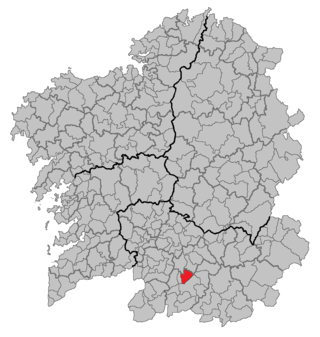
Sandiás is a municipality of Galicia, Spain, next to Xinzo de Limia in the province of Ourense. Its estimated population is 1,585, distributed among 3 parishes. Its area is 53 km2, a great part of which is drained fields from the Antela lagoon. This is an agricultural area. Potatoes and cereals are the most important crop. Sand extractions are also important for local development.

The Minho or Miño is the longest river in Galicia, with a length of 340 kilometres (210 mi). It forms part of the international border between Spain and Portugal. By discharge volume, it is the fourth largest river of the Iberian peninsula after the Douro, Ebro, and Tagus rivers.

Galicians are a Romance-speaking European ethnic group from northwestern Spain; they are closely related to the northern Portuguese people and has its historic homeland in Galicia, in the north-west of the Iberian Peninsula. Two Romance languages are widely spoken and official in Galicia: the native Galician and Spanish.

Hirakud Dam is built across the Mahanadi River, about 10 kilometres (6.2 mi) from Sambalpur in the state of Odisha in India. It is the longest earthen dam in the world. Behind the dam extends a lake, Hirakud Reservoir, 55 km (34 mi) long. It is one of the first major multipurpose river valley projects started after India's independence. Hirakud Reservoir was declared a Ramsar site on 12 October 2021.
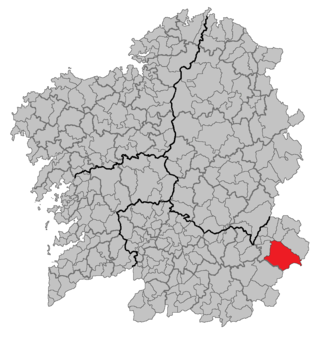
A Veiga is a municipality (concello) in the south-east of the province of Ourense in the autonomous community of Galicia, Spain. At 291 km², it is one of the largest concellos in the province. The capital is the town of A Veiga, also known as A Veiga or Santa María da Veiga to distinguish it from other towns and villages in Galicia of the same name. A Veíga is located 150 km from Ourense. The municipality has a population of 1,273 (2005), and a relatively low and decreasing population density.

Baltar is a municipality in the province of Ourense, in the autonomous community of Galicia, Spain. It belongs to the comarca of A Limia. The municipality has an area of area of 93.99 km. and its population was 986 in 2016. It shares a border with Portugal to the south.

Rairiz de Veiga is a municipality in the province of Ourense, in the autonomous community of Galicia, Spain. It belongs to the comarca of A Limia.

Marina of Aguas Santas (Marina of Ourense) (c.120–135 AD) is a virgin martyr from Aguas Santas, in the province of Ourense. The story of her life as it has been preserved is a mixture of fact and legends.

The Lima River runs west from the autonomous community of Galicia in Spain to Portugal, where it enters the Atlantic Ocean at Viana do Castelo, covering 108 kilometres (67 mi).
Potosí was a Venezuelan town in the western state of Táchira. The town was deliberately flooded by the Venezuelan government in 1985 to build a hydroelectric dam. In 2010, the town was uncovered for the first time since its flooding due to a drought caused by the weather phenomenon El Niño.
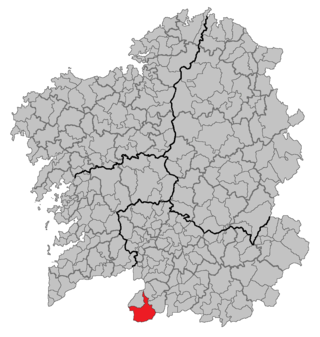
Ludeiros is a village in northwestern Spain in Ourense Province, and the autonomous region of Galicia. The village is in the municipality of Lobios and in the hills of the Peneda-Gerês National Park. It overlooks the Lindoso Reservoir, with the Rio Limia being the main river that drains into and out of the reservoir. Ludeiros is less than 500 metres (550 yd) from the Spanish-Portuguese border. The village is home to 35 residents.
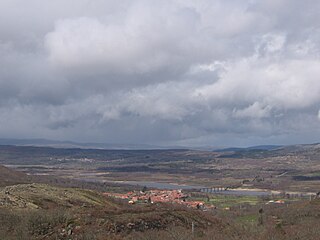
The Salas River is a tributary of the Lima. It rises in the Larouco mountains, within the municipality of Baltar, Ourense, Galicia. It flows through the territory of the Couto Misto, a former independent state, and the Portuguese village of Tourém before being dammed up by the Encoro de Salas, back in Spain. It flows into the Limia River near the town of Lobios.

Alto Lindoso Dam is a concrete double curvature arch dam on the Lima River. It is located in the municipality Ponte da Barca, in Viana do Castelo District, Portugal. The dam lies in Peneda-Gerês National Park close to the border with Spain. The reservoir created by the dam is known as Alto Lindoso reservoir or Lindoso reservoir.
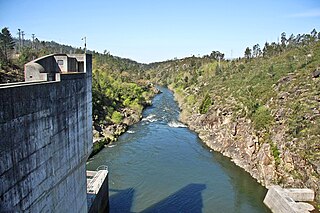
Touvedo Dam is a concrete gravity dam on the Limia. It is located in the municipality Ponte da Barca e Arcos de Valdevez, in Viana do Castelo District, Portugal.






















